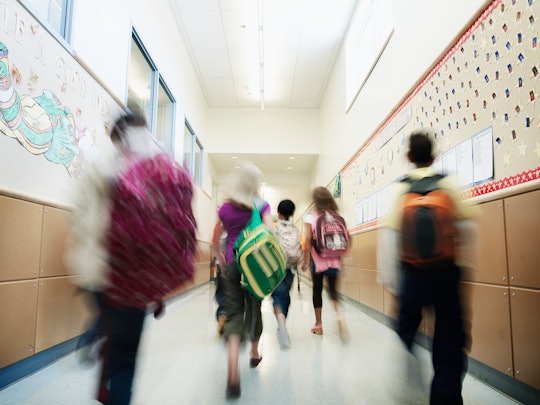News

CDC Says It's "Critically Important" To Open Schools This Fall In Updated Guidelines
As the coronavirus pandemic continues to be a pressing concern for families across the country, the Centers for Disease Control and Prevention (CDC) has released new guidelines for schools opening in the coming weeks. In them, the federal agency emphasized the "importance of reopening America's schools this fall."
"It is critically important for our public health to open schools this fall," CDC Director Dr. Robert R. Redfield said in a statement released Thursday. "The CDC resources released today will help parents, teachers and administrators make practical, safety-focused decisions as this school year begins. I know this has been a difficult time for our Nation’s families. School closures have disrupted normal ways of life for children and parents, and they have had negative health consequences on our youth. CDC is prepared to work with K-12 schools to safely reopen while protecting the most vulnerable."
The CDC's statement was released on the same day Johns Hopkins University's COVID-19 tracker reported that the United States now has over 4 million confirmed cases of coronavirus and over 144,000 deaths.
While CDC recommends schools across the country prepare to reopen in the fall as safely as possible, local officials living in any areas where there remain "substantial, uncontrolled" spread of the coronavirus should consider leaving schools closed for the time being. "If community transmission levels cannot be decreased, school closure is an important consideration," the CDC says in the guidelines. "Plans for virtual learning should be in place in the event of a school closure."
Back in May, the CDC shared recommendation checklists for schools and businesses to follow in the event of reopening. At the time, the recommendations were based on lowest to highest risk situations, and largely focused on following safe preventative measures like physical distancing and good hygiene. The latest recommendations released Thursday offer a set of safety guidelines and protocols for schools that plan to reopen in the fall.
"Schools are an important part of the infrastructure of communities and play a critical role in supporting the whole child, not just their academic achievement," the CDC said. "This guidance is intended to aid school administrators as they consider how to protect the health, safety, and wellbeing of students, teachers, other school staff, their families, and communities and prepare for educating students this fall."
According to the CDC, school administrators should implement the following measures:
- Ensure physical distancing measures are being followed
- Educate and reinforce proper hygiene like vigorous hand washing
- Wear face coverings
- Implement cohorting, which is grouping people together based on their risk of infection
- Encourage not just students and staff but all members of the community to practice these preventive measures
- Clean and disinfect environments on a regular basis
- Find ways to repurpose underused areas of schools, like empty classrooms and outdoor spaces, to simplify physical distancing criteria
- Develop plans to be used if someone in the community tests positive for COVID-19
- Work with local and state health officials to find ways to trace positive cases
- Ensure schools are up to date regarding COVID-19 transmission and response in their local areas.
Over the last few weeks, the United States has seen spike in positive coronavirus cases, with 10 states reporting more than 10,000 new cases, according to data from the CDC. In its new guidelines for schools, the CDC pointed to scientific research that has found the coronavirus does not appear to be transmitted through children as frequently as adults, nor do children seem to suffer severe symptoms.
"Based on current data, the rate of infection among younger school children, and from students to teachers, has been low, especially if proper precautions are followed. There have also been few reports of children being the primary source of COVID-19 transmission among family members," the CDC said, adding that "no studies are conclusive, but the available evidence provides reason to believe that in-person schooling is in the best interest of students, particularly in the context of appropriate mitigation measures similar to those implemented at essential workplaces."
The CDC also noted that "the harms attributed to closed schools on the social, emotional, and behavioral health, economic well-being, and academic achievement of children, in both the short- and long-term, are well-known and significant."
Before the CDC released these guidelines, President Donald Trump had been pushing for states to reopen schools in the fall and even threatened to cut funding from those that they do not fully reopen. "We cannot indefinitely stop 50 million American children from going to school — harming their mental, physical, and emotional development," Trump said during a press conference at the White House. "Reopening our schools is also critical to ensuring that parents can go to work and provide for their families."
While there's no doubt that public health officials, teachers, parents, students as well as the president all want to see schools open and operating safely this fall, many parents have expressed concern about sending their children back into the classroom too quickly. As ChalkBeat reported, a recent poll from the National Parents Union Coronavirus Impact Survey found that 54% of parents said "schools should remain closed until they are certain there is no health risk, even if it means students fall farther behind," while 36% of parents said "schools should reopen as soon as possible so students don’t fall too far behind and can receive the educational support they need."
If you think you’re showing symptoms of coronavirus, which include fever, shortness of breath, and cough, call your doctor before going to get tested. If you’re anxious about the virus’s spread in your community, visit the CDC for up-to-date information and resources, or seek out mental health support. You can find all of Romper’s parents + coronavirus coverage here.